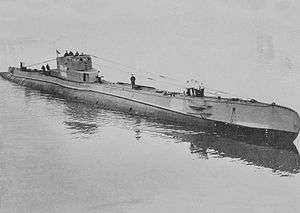Orzeł incident
The Orzeł incident[1] occurred at the beginning of World War II. The Polish submarine ORP Orzeł escaped from Tallinn in then-neutral Estonia. The Soviet Union used the incident as a pretext to justify the eventual annexation of Estonia.
The incident

The Orzeł was in the Baltic Sea when Nazi Germany attacked Poland, setting off World War II. Unable to reach a Polish naval base and with the captain, Lieutenant-Commander Henryk Kłoczkowski, seriously ill, the decision was made to head for Tallinn, which was reached on 14 September 1939. Kłoczkowski was taken to a hospital the next day for treatment of the unidentified illness he had been suffering from since 8 September.
Section XIII, Article 8 of the Hague Convention of 1907 required that a neutral government had a duty "to prevent the departure from its jurisdiction of any vessel intended to cruise, or engage in hostile operations"[2] against another government with which the neutral was not at war. At the insistence of the Germans, the Estonian military authorities boarded the ship, interned the crew, confiscated all the navigation aids and maps, and commenced dismantling all the armaments.
The crew of ORP Orzeł conspired to escape under the new command of its chief officer, Lt. Jan Grudziński VM VM DSO. On 18 September, the partially submerged Orzeł slipped out of the harbour under the cover of a foggy night, with the two on-board Estonian guards taken hostage. The Estonian and German press covering the incident declared the two captured guards had been murdered by the Polish sailors. However, they were deposited on the Swedish coast and provided with clothing and food for their safe return home. The two guards were also provided with 50 US dollars each, as the Polish crew believed that those returning from the underworld "deserve to travel first class only". Orzeł headed to the Royal Navy base at Rosyth in Scotland.
Repercussions
The Soviet Union, which invaded Poland on 17 September 1939, accused Estonia of conspiring with the Polish seamen and "aiding them to escape", challenging the neutrality of Estonia. The Soviets demanded to be allowed to establish military bases on Estonian soil, threatening war if Estonia did not comply. This was simply a convenient pretext; the Molotov-Ribbentrop Pact had already given German approval to the Soviet Union taking over the Baltic countries. The Orzeł incident was used to force a "pact of defence and mutual assistance" on Estonia, which was signed on 28 September 1939, and led to the occupation and annexation of Estonia by the Soviet Union in 1940. Orzeł sank no enemy vessels during her journey from Estonia to Britain, although Soviet authorities blamed her for sinking the Soviet tanker Metallist in Narva Bay on 26 September, the incident being used as a pretext for the Soviet invasion of the Baltic states. Based on "SEA CLASSIC" vol.16, NO:2 March 1983,Page 21: the ORZEL did sank the German merchant ship: MS RIO de Janeiro, the 9.800ton vessel on April 9, 1940.
References
- ↑ His Majesty's Submarines; p 19; ISBN 1-57638-021-1
- ↑ "CONVENTION CONCERNING THE RIGHTS AND DUTIES OF NEUTRAL POWERS IN NAVAL WAR".
